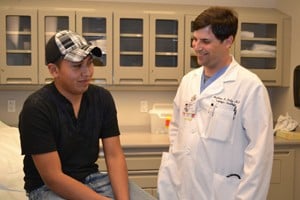Laparoscopic Surgery Is State’s First for Testicular Cancer Patient
April 21, 2011 | Matthew Katz, M.D., a urologic-oncologist at the University of Arkansas for Medical Sciences (UAMS), recently performed what is believed to be the first minimally invasive surgery in Arkansas to remove lymph nodes in a patient with testicular cancer. The procedure spares patients the traditional foot-long, open-incision surgery. Instead, Katz was able to remove the lymph nodes through three incisions, each about one inch long. Laparoscopic surgery requires special tools that can fit through the small incisions, including a laparoscope, which is a tiny camera that allows the surgeon to see inside the body. “I’m doing great,” said Gustavo Osario, 21, who was back to normal activities just a month after surgery. “I’m glad that I was the first person in Arkansas to have the surgery without the big incision.” Osario was referred to UAMS for the lymph node removal by an outside physician who removed his cancerous left testicle. Although the cancer was only clinical stage 1, it was an aggressive type, which led to the decision to remove the lymph nodes. The laparoscopic surgical approach is difficult because the lymph nodes that need to be removed are along the main blood vessels leading to and from the heart called the aorta and inferior vena cava. “This is an important advance, because the patient’s pain and recovery time is significantly reduced, yet the laparoscopic approach replicates the open procedure,” said Katz, who was assisted in the surgery by Brian Badgwell, M.D., a UAMS surgical oncologist. “The hospital stay is normally seven days or greater with the traditional open surgery, but Gustavo was home in just three days.” Katz noted that testicular cancer is the most common cancer for men ages 18 to 35, with that age group receiving 53.7 percent of all testicular cancer diagnoses, according to the National Cancer Institute. Katz, who joined UAMS last year, is the only two-year Society of Urologic Oncology accredited fellowship-trained urologist in Arkansas. His advanced training brings new treatment techniques to UAMS, including new approaches in laparoscopic robotic-assisted removal of kidney tumors and robotic-assisted bladder removal. He also recently performed – with the help of UAMS’ Stephen Canon, M.D. – the first robotic pediatric urologic surgery in Arkansas. Katz’s unique skills in performing the Laparoscopic Retroperitoneal Lymph Node Dissection were honed during an intensive two-year combined fellowship in minimally invasive urologic oncology and endourology/laparoscopy at Washington University School of Medicine in St. Louis. Osario’s prognosis is good. No cancer was found in his lymph nodes, and Katz was able to use nerve-sparing techniques that preserve Osario’s fertility. Also, by undergoing this surgery, Osario did not need chemotherapy treatment. The American Cancer Society estimated that about 8,480 new cases of testicular cancer would be diagnosed in the United States in 2010 and that about 350 men would die of testicular cancer. Although the rate of testicular cancer has been rising, it is not common; a man’s lifetime chance of developing testicular cancer is about 1 in 270, according to the American Cancer Society. Because treatment is so successful, the risk of dying from this cancer is about 1 in 5,000. |
